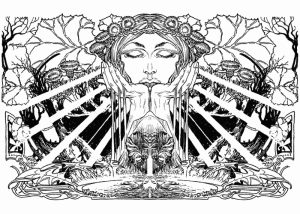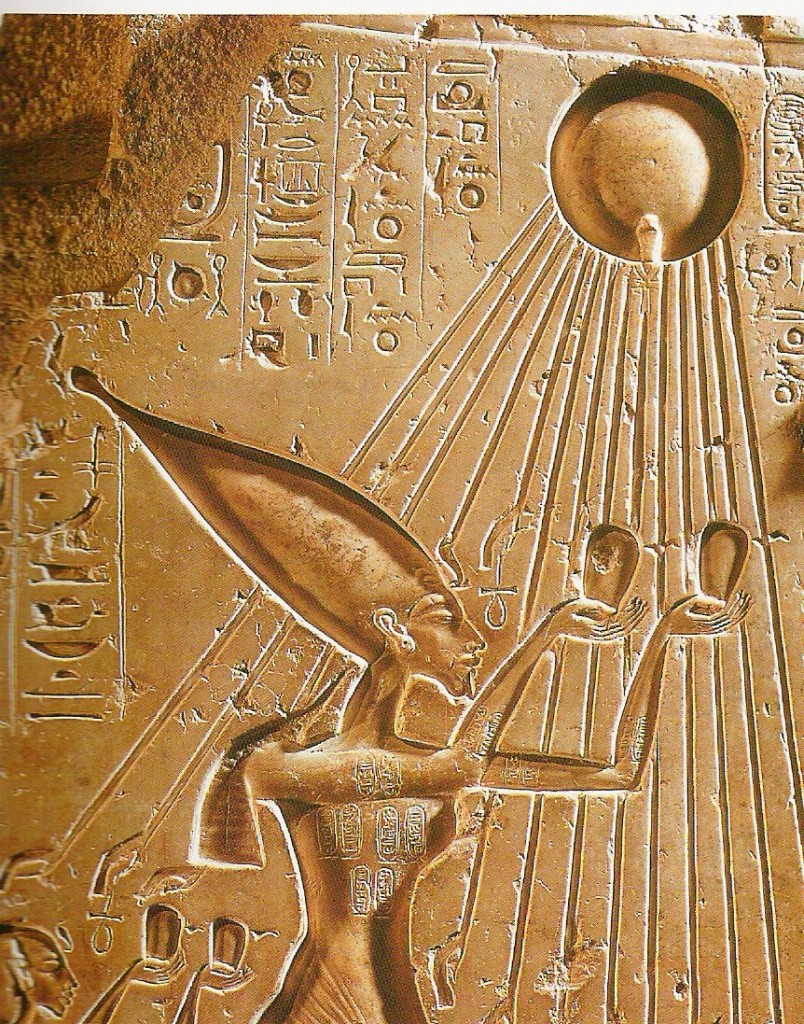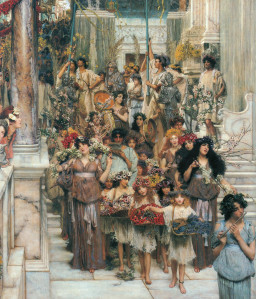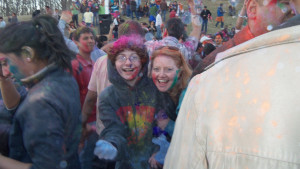We’re coming up on our family Midwinter celebration. (We call it “midwinter” because it is the middle of winter, not the beginning of spring here in the Midwest.) Here’s my outline for the upcoming celebration. It includes a ritual burning of a piece of paper on which something is written. I very much dislike how ubiquitous this ritual is in Neopagan practice, but I do use it in this one celebration. The ritual is geared for my non-Pagan wife and my children, ages 9 and 13.
Midwinter 2012

Prelude: “Hail Brigid” by Sharon Knight
Hail Brigid of the triple face
Whose voice does rise on the lilt of grace
Whose blossoms beautiful ever bloom
On the wings of poetry’s sweet perfume
Alternative Prelude: “Brighid’s Flame” by Kellianna
I am the spark before the fire
from winters cold I do inspire
I am the promise of the Spring
I am the tiniest of flames.
A dancing fire upon the snow
in darkest night a mighty glow
I circle toward the coming spring
I am all life awakening.
Mid-Winters’ slumber I do shake
I coax the seed and bulb to wake
I pull them slowly from their dreams
I am the Maiden of the flame.
Protecting all at time of birth
In love and safety draw them forth
I wrap all newborns in my light
I am the Maiden dressed in white.
Introduction
Today we celebrate the day that many pagans call Imbolc. It is the next station on the Wheel of the Year, after Yule or the winter solstice. Imbolc is half way through the winter, which began at Yule, so we call it Midwinter. It is also half way to the spring equinox, which is the beginning of spring.
This is also the day that we in America call “Groundhog’s Day”? Do you know what the story is about Groundhog’s Day? [Let the kids answer.] The truth is that there are always 6 more weeks of winter after Groundhog’s Day, until the Spring Equinox when spring begins. This is the day that we celebrate winter being half way over. Imbolc is an ancient Irish name, which means “in the belly”, and it makes us think about the seeds that are growing in the belly of the earth that will be born in spring.
Ireland is a very special place for many pagans. In Ireland, Paganism and Christianity mixed in a unique way. One way was that the Pagan Goddess Brigid was merged with the Christian saint Brigit, and their holiday is celebrated the same day, today. Saint Brigit is honored by an eternal flame that is always kept burning in Kildare, Ireland. Similarly, fire was especially sacred to the pagan goddess Brigid. In addition, healing waters are sacred to both the Christian Saint Brigit and the pagan Goddess Brigid.
In tonight’s ritual, both water and fire will play an important part. We honor water for its healing and renewing powers. He honor fire for its power to transform.
This day is also special to many Christians who celebrate it as Candlemas or the Feast of the Purification or Feast of the Presentation. The Bible tells that 40 days after Jesus was born, Mary took her new baby to the Temple to be blessed. And Mary went to the temple to be purified, which was in accordance with Jewish law for women who had given birth. Christians celebrate Candlemas by blessing the candles that will be used for the rest of the year.
In the pagan tradition, this is the day when the Goddess turns from an old woman back into a young maid. Every year the Goddess begins the year young and then grows older as the seasons pass, until she is renewed again at midwinter. She grows old, but never dies. This reminds us that, even when the world grows cold and dark, Life always continues.
In honor of both the pagan and the Christian stories, we honor this day as a time for new beginnings and time for transformations.
“Lament of the Old Woman” (adapted from “Lament of the Old Woman of Beare”, 10th c. CE, Ireland)
The poem below comes from an ancient Irish poem. It is a sad poem written by an old woman who misses the days of her youth. But it ends with the promise of hope. It begins with the words “ebb tide” has come to me. Do you know what the tide is? Do you know what the ebb tide is? [low tide]
Ebb tide has come to me as the sea.
The sea crawls from the shore, leaving weeds like a corpse’s hair.
The sea slouches away from me, leaving me with salt on my lips.
Time was the sea brought kings as slaves to me.
Now the sea brings only images of the drifting dead.
Women love only riches now.
But when we lived, we loved men,
young men whose horses galloped in the open plain,
beating lighting from the ground.
I loved such men.
I feasted by the light of many bright candles.
Now I pray in the darkness of the oratory.
I drank my fill of wine and mead with kings,
their eyes lingering on my hair.
Now I drink the bitter dregs with shriveled hags and my hair is gray.
My skin, where glorious kings once pressed their lips, is now tight and thin.
My arms that once practiced the pleasant craft,
caressing the bodies of comely youths, are now bony and thin.
Then I wore garments of every hue and a cloak of green.
Now the veil that covers my hair is black and mean.
The wine thrilled me to my fingertips.
And I stretched at the side of him who would take me briefly for his bride.
The storms have long since reached the stone chair of the kings.
Their tombs are old and crumbling.
The maidens rejoice when May Day comes to them.
But I have spent the summer of my youth.
I hold no sweet converse.
No gelded rams are killed for my wedding feast.
What the flood-tide brings, the ebb-tide takes away.
I have known the flood and I have known the ebb.
The sun does not touch me.
In me I feel the cold.
But still a seed burns there.
The time is at hand that shall renew me.
The Return of Ishtar
I have one more story for you. Do you remember the story of the Goddess Ishtar? [Here is a link to my favorite children’s book about Ishtar.] How she loved a man named Tammuz? But she became angry with him and sent him down into Underworld. Do you remember what happened when Tammuz went into the Underworld? [All the plants and animals started to die. And the people began to weep and pray for his return.]
So Ishtar decided to make the dangerous journey to the dark Underworld. She put on the seven veils of a priestess and her seven queenly jewels and she went down to the first gate of the Underworld. Do you remember how many gates there were? And at each of the seven gates, Ishtar had to give something to the gatekeeper. In one version, he had to give up one of her seven jewels, one by one. In another version, she had to surrender one of her seven veils, one by one. In another version, she had to give him parts of her self, her soul, piece by piece until there was almost nothing left.
But when she got to the Underworld, Ishtar defeated the Queen of Death by the power of love. And she restored her lover Tammuz with water from the Well of Life. And was given freedom to return back to the land of light and life with Tammuz. And as she went through each of the seven gates, the gate keeper returned to her each of jewels or her veils or the parts of her self. And each time he returned something to her, he said: The power of your living flame will rise again. And she said: May I never lose my way back to the well of life. Until at last Ishtar stood at the doorway of the horizon at dawn. And the bolt of the last gate was drawn back. And Ishtar opened the double doors of the tomb and ascended with her lover Tammuz.
The Bible tells how woman remembered the loss of Tammuz and Ishtar every year in the summer months by “weeping for Tammuz”. Six moths later, in the middle of winter, Neopagans celebrate the beginning of the return of Ishtar from the Underworld. At this time of the year, we are celebrating the return of the light to the world, as the days slowly grow longer. We will light a candle today to symbolize Ishtar passing through the first gate of the dark underworld on her way back to the land of light and life. And for the next six weeks, we will light another candle one each week, until the spring equinox, which marks the beginning of spring.
Light one of the candles saying:
The power of her living flame will rise again.
May we never lose our way back to the well.
“The First Melt” (adapted from Woodland’s song by the same name)
Go outside and gather snow in bowls. Bring the snow into the house and pour it into the cauldron while reciting the excerpts from the poem below:
My daughter:
Melt the ice that stills you,
in this season that chills you,
may the fire within you,
be lit by this hearth.
All together: Refrain
Bring the cold, cold water,
from the dark, dark well,
to the warm hearth fire,
when the ice begins to melt.
My son:
May the days grow longer,
as the fire grows stronger;
may the waking of spring,
be the light in your dark.
All together: Refrain
My wife:
When the nights grow warmer,
may your heart grow stronger;
may the first melt of light
warm your dreams in the night.
All together: Refrain
The Triple Goddess
Neopagans believe the Goddess is the world around us, all of Nature, including the earth, the air and the sky, and all living things, even us. We watch the world undergo a change every year, so we imagine the Goddess also changing: from a young woman, into bride and a mother, and then into a wise older woman, and then back into a young woman.
Each of these candles represents the Goddess is one of the four seasons:
In the winter (in February), she wears a white gown like the snow on the ground.
In the spring (in May), she wears a green gown like the new grass in the fields.
In the summer (in August), she wears a red gown like the fire of the setting sun.
In the fall (in November), she wears a black gown like the nights which are growing longer.
The Charge of the Goddess (adapted from Doreen Valiente’s “Charge of the Goddess”)
Have each person light one of the candles and place it under the cauldron (at the appropriate cardinal point) reading the quote below. Light the black candle.
BLACK (NORTH)
You are the Cauldron of Immortality. From you all things proceed, and unto you all things must return. You have been with us from the beginning, and you wait for us at the end of all desire.
Pass the flame to the red candle.
RED (WEST)
You are the mystery of the waters. You teach compassion, humility, and reverence. Yours is the secret door which opens upon the Land of Rebirth.
Pass the flame to the green candle.
GREEN (SOUTH)
Your are the beauty of the Green Earth. Yours is ecstasy of the spirit and joy on earth. All acts of love and pleasure are your rituals.
Pass the flame to the white candle.
WHITE (EAST)
You are the Beauty of the white Moon among the stars. Yours is the Cup of the Fountain of Youth. You are the Soul of Nature which gives life to the universe.
“The Cauldron of Inspiration” (adapted from the Mabinogion)
The Cauldron is an ancient symbol for the Irish. It is a symbol of plenty, like a cornucopia. There is a story about a magical cauldron that never ran out of food. It is also a symbol of change. There is a story about a cauldron that could bring the dead back to life. I’m going to tell you the most famous story about a cauldron.
Once upon a time, there was a goddess named Cerridwen. [Can you say “Cerridwen”.] Cerridwen was a wise and powerful goddess, but she also had terrible temper. One day she decided to make a magical potion that would make the person who drank it wise and give them magical powers. She planned to give the potion to the child that she hoped to have one day.
This potion was very difficult to make. It took an entire year to make. And even then, only the first drop of the potion would have the magical power. Cerridwen began by filling the cauldron with water. And she set the cauldron over the fire. Then each day she added different herbs that she collected. She had to add the herbs at precisely the right time. And she could tell when the time was right by watching the stars.
While she was out collecting herbs, Cerridwen left a young boy to stir the pot and to keep the fire going. His name was Gwion. And Gwion kept the cauldron stirring for the entire year. On the last day, Cerridwen brought the last of the magic herbs to the cauldron. Gwon continued to stir the cauldron. But when she cast the herbs into the cauldron, the herbs splashed and a drop of the potion landed on Gwion’s finger and burned him. And he instinctively put his hand into his mouth. [And what do you think happened?]
Gwion suddenly became wise. But in that instant, Cerridwen realized what had happened, and she screamed with rage. Gwion took off running and Cerriwen followed him. Gwion ran as fast as he could, but Cerridwen was gaining on him. In desperation, Gwion imagined himself running as fast as a rabbit. And suddenly, he turned into a rabbit, running and darting as fast as a flame. But when he looked back, the Goddess had turned into a hunting dog and was gaining on him.
The little rabbit Gwion saw a river ahead, and he plunged into the river and turned into a fish, darting away like a splash of water. But when he looked back, Cerridwen had turned into an otter and was swimming after him. So Gwion jumped out of the water and into the air, turning himself into a little bird. Gwion flew away, but when he looked back, he saw the Goddess had turned herself into a hawk. And she was diving on him with her talons outstretched.
So the little bird Gwion looked for some place to hide. And he saw a farm. And on the farm was a pile of grain that had been gathered. So Gwion turned himself into a kernel of grain and hid among all the little grains. But the Goddess turned herself into a hen and started eating the grain, until the grain was all gone, including the little grain the was Gwion. [Pause.]
But the story doesn’t end there. [What do you think happened then?] Soon the Goddess noticed that her belly was slowly getting bigger. And over the months it got bigger and bigger, until nine months later, she gave birth to a beautiful young boy with golden hair. And she loved him and she named him Taliesin. And he became the most famous magician in all of Britain.
What do you think the moral of the story is? How many different changes happened in the story? Cerridwen was angry because she didn’t get her way. But in the end, she got exactly what she wanted. But she could never have predicted how all those different changes would make that happen.
Song: “Ooh Child”
Ooh-oo child, Things are gonna get easier
Ooh-oo child, Things’ll get brighter
Ooh-oo child, Things are gonna get easier
Ooh-oo child, Things’ll get brighter
Some day, We’ll put together what was commin’ undone
Some day, We’ll tie it all tighter
Some day, We can lay in the rays of a beautiful sun
Some day, The sky will be brighter
[refrain]
Some day, It won’t be long when I see you again
Some day, The time will be tighter
Some day, We’ll loose the blue and the hurt in your heart
Some day, Then my heart will be lighter
[refrain]
Lavatio
Return to the cauldron after the snow has melted. (Be prepared to pour some pre-melted water into the cauldron if the snow has not melted sufficiently.) Extinguish the black, red, and green candles. Remove the white candle to a plate (leaving it burning).
Recite the mantra below:
I have known the flood and I have known the ebb.
What the flood-tide brings, the ebb-tide takes away.
Wash your hands while thinking about something you want to start new.
Dry your hands.
Now write on a piece of paper something you want to transform in your life.
Now burn the paper in the white candle flame and recite the mantra below:
I feel the cold in me.
But still a seed burns within.
The time is at hand that shall renew me.
Now take a card from the Wisdom of the Hidden Realms oracle deck. This card will represent a possibility for the new year. If you do not like the card you selected, you may choose another. If you are comfortable, share your card with everyone and what it means to you.
Song: “Brighid’s Kiss” by Trinity
We will dance in a circle holding hands moving in one direction to the rhythm of the song, and then change directions with each verse.
Gabbaim molta Bríde (I praise Brighid)
Ionmhain í le hÉirinn (Beloved of Ireland)
Ionhain le gach tír í (Beloved of all lands)
Molaímis go léir i (Let us all praise her)
Lóchrann geal na Laighneach
(The bright torch of Linster)
A’ soilsiú feadh na tíre (Shining throughout the land)
Cean ar óghaibh Éireann (The pride of all Irish women)
Ceann na mban ar míne
(The pride of women for gentleness)
Tig an geimhreadh dian dubh (Comes the hard dark winter)
A’ gearradh lena ghéire (Cutting with it’s severity)
Ach ar Lá ‘le Bríde (But on St. Brighids Day)
Gar dúinn earrach Éireann (The Irish spring is near to us)
Brighid of the sunrise
Rising in the morning
Rising with the springtime
Greening all the land
See you in the soft cloud
See you in the raindrop
See you in the winds of change
Blowing through the land
You the red eared white cow
Nourishing the people
Nourish now the hunger
Souls longing in our land
Bird that is unfolding
Now the time’s upon us
Only have we eyes to see
Your Epiphany
[Instrumental]
You the red eared white cow
Nourishing the people
Nourish now the hunger
Souls longing in our land
Bird that is unfolding
Now the time’s upon us
Only have we eyes to see
Your Epiphany
Gabbaim molta Bríde (I praise Brighid)
Ionmhain í le hÉirinn (Beloved of Ireland)
Ionhain le gach tír í (Beloved of all lands)
Molaímis go léir i (Let us all praise her)















